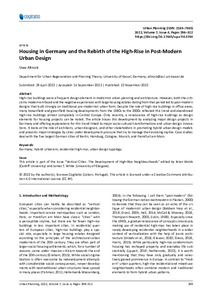Housing in Germany and the Rebirth of the High‐Rise in Post‐Modern Urban Design
| dc.date.accessioned | 2023-02-03T12:14:21Z | |
| dc.date.available | 2023-02-03T12:14:21Z | |
| dc.date.issued | 2022-11-22 | |
| dc.identifier | doi:10.17170/kobra-202302037450 | |
| dc.identifier.uri | http://hdl.handle.net/123456789/14398 | |
| dc.description.sponsorship | Gefördert durch den Publikationsfonds der Universität Kassel | ger |
| dc.language.iso | eng | |
| dc.rights | Namensnennung 4.0 International | * |
| dc.rights.uri | http://creativecommons.org/licenses/by/4.0/ | * |
| dc.subject | Germany | eng |
| dc.subject | hybrid urbanism | eng |
| dc.subject | residential high-rise | eng |
| dc.subject | urban design typology | eng |
| dc.subject.ddc | 690 | |
| dc.subject.ddc | 710 | |
| dc.title | Housing in Germany and the Rebirth of the High‐Rise in Post‐Modern Urban Design | eng |
| dc.type | Aufsatz | |
| dcterms.abstract | High-rise buildings were a frequent design element in modernist urban planning and architecture. However, both the criticisms modernism faced and the negative experiences with large housing estates dating from that period led to post-modern designs that built strongly on traditional pre-modernist urban form. Despite the role of high-rise buildings in office areas, many brownfield and greenfield housing developments from the 1980s to the 2000s reflected this trend and abandoned high-rise buildings almost completely in Central Europe. Only recently, a renaissance of high-rise buildings as design elements for housing projects can be noted. The article traces this development by analyzing major design projects in Germany and offering explanations for this trend linked to major socio-cultural transformations and urban design innovations. It looks at the role of architects, urban designers, and other stakeholders in promoting hybrid urban design models and presents major strategies by cities under development pressure that try to manage their evolving skyline. Case studies deal with the five largest German cities of Berlin, Hamburg, Cologne, Munich, and Frankfurt am Main. | eng |
| dcterms.accessRights | open access | |
| dcterms.creator | Altrock, Uwe | |
| dc.relation.doi | doi:10.17645/up.v7i4.5744 | |
| dc.subject.swd | Deutschland | ger |
| dc.subject.swd | Stadtgestaltung | ger |
| dc.subject.swd | Urbanität | ger |
| dc.subject.swd | Hochhaus | ger |
| dc.subject.swd | Wohnen | ger |
| dc.type.version | publishedVersion | |
| dcterms.source.identifier | eissn:2183-7635 | |
| dcterms.source.issue | Issue 4 | |
| dcterms.source.journal | Urban Planning | eng |
| dcterms.source.pageinfo | 298–312 | |
| dcterms.source.volume | Volume 7 | |
| kup.iskup | false |
Dateien zu dieser Ressource
Das Dokument erscheint in:
-
Artikel [1223]


